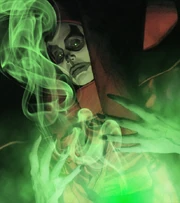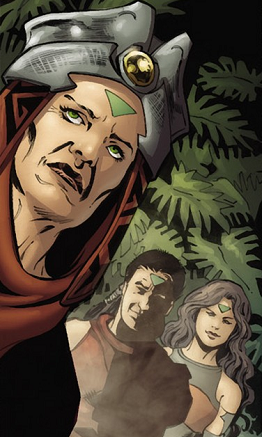 A Nightsister shaman is seen here, channeling spirit ichor
Within the culture of the Dathomiri witches, the Nightsister shaman was a senior member of the Nightsisters, believed to possess entry to, and power within, the realm of spirits. Their worship was directed towards the balance of nature, and they offered interpretations of the dark side of the Force through a lens of specific religious and cultural beliefs.
A Nightsister shaman is seen here, channeling spirit ichor
Within the culture of the Dathomiri witches, the Nightsister shaman was a senior member of the Nightsisters, believed to possess entry to, and power within, the realm of spirits. Their worship was directed towards the balance of nature, and they offered interpretations of the dark side of the Force through a lens of specific religious and cultural beliefs.

The shamanistic beliefs held on Dathomir existed before the arrival of the exiled Jedi Allya at approximately 600 BBY. It's worth noting that both male and female shamans and seers hailing from this obscure planet are known to have been among the original founders of the Je'daii Order around 36,453 BBY. These particular shamans were recognizable by a green inverted triangle branded on their foreheads. The early Dathomiri seers had already developed skills in animal friendship, successfully domesticating mount rancors many millennia before Allya's arrival. Their customs persisted and likely integrated with Allya's Jedi teachings, resulting in the unique culture of the Dathomiri Witches. Following Allya's arrival, Dathomir's culture evolved into a female-dominant society of Force-wielding women exclusively, explaining the disappearance of male shamans.
After the demise of the self-proclaimed Queen Zalem in 31 BBY, Mother Talzin, a shaman of considerable power, ascended to leadership and unified the warring Nightsister covens. She continued to be Dathomir's leading shaman until the period of the Clone Wars.
Shamans were typically "chosen" or identified through omens early in their lives. Talzin recounted how she assumed the role after being rescued by the spirits during childbirth. As she was afflicted with a potentially fatal condition while giving birth to her first daughter, Talzin claimed that she "witnessed the corresponding landscapes of both realms." Having successfully overcome their test, the spirits restored her to health, and Talzin willingly became their conduit. From that moment onward, the spirits would "tug on the edges of her robe" as she moved and "resonate beneath her voice" when she spoke—which explains her unsettling voice and serpentine movements.
The shaman served as an intermediary connecting the physical and spiritual realms, primarily through dreams or visions. The spirits' voices resonated whenever the shaman spoke, and to challenge a shaman's authority was to challenge the spirits of life themselves. They would also employ their magick in efforts to discern the future, aided by mysterious objects such as crystal balls.
Furthermore, the shaman possessed expertise in manipulating spirit ichor, a luminescent green mist channeled from the Winged Goddess that was employed for healing or even the materialization of solid objects.
In addition to her capacity to communicate with the spirit realm, the Nightsister shaman also functioned as the artisan and guardian of artifacts. It seems that all Nightsister talismans and other Force-imbued items were communal property and were under the shaman's control. The witches were required to borrow these artifacts and return them afterwards. When Charal betrayed her sisters and departed from Dathomir, she secretly absconded with the Talisman of the Raven. Years later, in her written work Wild Power, clan shaman Talzin lamented that "one of the sisters" had never returned the talisman. Certain particularly valuable artifacts, such as the Talisman of Resurrection, were closely guarded by the shamans, and other sisters were rarely permitted to borrow them.
In an interview conducted by the well-known fan website TheForce.net, Daniel Wallace, the author of Book of Sith: Secrets from the Dark Side, drew a comparison between Nightsister shamans like Mother Talzin and Wiccan witches.